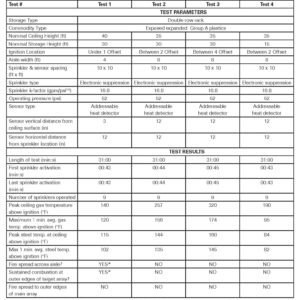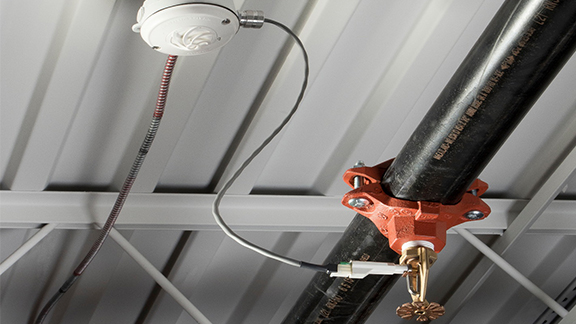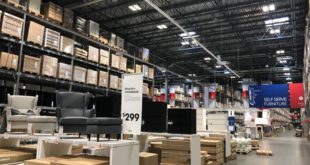How an Electronic Sprinkler System Can Meet the Demands of Today’s Storage Needs
Automatic fire sprinklers have remained relatively unchanged since their introduction in the 1800s. Advancements have been made, allowing for protection of more complex spaces and fire hazards, but the underlying fundamentals of how a sprinkler operates have not. Current fire sprinkler technology built on those fundamentals has become a limiting factor to rapidly evolving end-user needs. These needs, driven by ever-evolving technology, are seen clearly in the storage and warehousing sectors where e-commerce has changed the way consumers shop, forcing companies to change how they service them. Fast isn’t fast enough – two-day, overnight and same-day delivery are quickly becoming an expectation and logistics must evolve to support customer demands.
The Johnson Controls research and development team recognized that fire sprinklers were making it challenging for end-users to keep pace with the needs of their warehouses while also keeping their fire sprinkler systems up to code. The team approached the next evolution of storage protection by asking: What if your sprinkler system could think? What if your sprinkler system didn’t rely on the unknowable factors when facing a fire, such as sprinkler skipping? What if your sprinkler system knew where the fire was and could start controlling it sooner? The electronic sprinkler system can do all these things.
The UL Listed electronic sprinkler system consists of K16.8 ESFR sprinklers operated by an “intelligent” electronic sensing and control system. Electronic sensors detect the rate of temperature rise, which allows for quicker detection of a heat source. Once a fire is validated by multiple sensors, the system activates an array of sprinklers simultaneously to “surround and drown” the fire. This technology gets water to the fire sooner, avoids sprinkler skipping, maximizes the amount of water applied to burning materials, and pre-wets adjacent unburned fuels to help prevent lateral fire spread. This concept was validated with multiple full-scale fire tests performed at the Underwriters Laboratories large burn lab facility in Northbrook, Illinois.
The test setup consisted of standard Exposed Expanded Plastic (EEP) commodity – polystyrene meat trays shrink wrapped on oak pallets and stored on double-row racks under a 35-ft and 40-ft smooth flat ceiling. The sprinkler used in the testing consisted of an existing commercially available ESFR sprinkler with a k-factor of 16.8 gpm/psi 0.5 that was modified to operate electrically. The detection and control system utilized standard addressable heat sensors that were hard-wired to a commercially available fire control panel. There was a single heat sensor located within 12-in. horizontally above every sprinkler. The panel was programmed to operate up to nine sprinklers simultaneously through basic control logic. Sprinklers were selected for operation using a sensitive rate-of-temperature-rise detection algorithm, and activated once specific triggering criteria were achieved. Figure 1 details the set up for four full-scale tests that were performed.

During the test series the following observations were made:
- In all tests, nine sprinklers operated simultaneously at or before the first ESFR sprinkler activation would typically have been observed.
- In all tests sprinkler operating arrays were contiguous and roughly centered around the point of fire ignition.
- In all tests the damage was limited to within two pallet loads laterally in either direction from ignition, well within the envelope of sprinkler operation with a significant wetted margin.
- Minor aisle jump was observed in Test 1 only, and was principally caused by burning commodityfalling into the narrow 4-ft wide aisle and igniting a single pallet load on the target array opposite ignition. During the course of the test this single pallet load was partially consumed. Due in part to this observation, Tests 2-4 were conducted using a wider 8-ft aisle.
- In all tests significant fire suppression was achieved within approximately 90 seconds from initial sprinkler operation
* Burn through of a single pallet at very bottom of target array ignited by falling debris from main array.
The results of this investigation demonstrate that the simultaneous activation of fire sprinklers surrounding the point of fire origin electric fire sprinklers operated by an “intelligent” fire detection and control system can provide adequate protection of exposed expanded group-A plastics stored on racks in warehouse applications without the need for vertical barriers. Further, protection can be achieved with up to 55 percent lower total system water demand as compared to existing alternatives.
REFERENCES:
1. UL LLC, “Protection of Rack Stored Exposed Expanded Group A Plastics with ESFR Sprinklers and Vertical Barriers” 2012, Fire Protection Research Foundation, Quincy, MA.
2. NFPA 13 Standard for the Installation of Sprikler Systems, 2016 Edition, NFPA, Qunicy, MA.
3. “Sprinkler Protection Criteria for Exposed Expanded Group A Plastics Project Summary” 2014, Fire Protection Research Foundation, Quincy, MA.
ABOUT THE AUTHOR: Gaurav Malik is global product manager of storage sprinklers and enterprise software, building technologies and solutions at Johnson Controls.
 Sprinkler Age A Publication of the American Fire Sprinkler Association
Sprinkler Age A Publication of the American Fire Sprinkler Association

